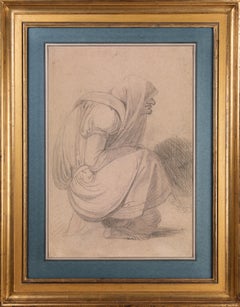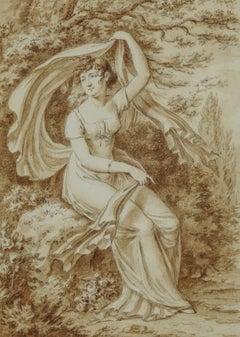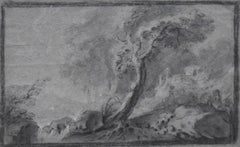Henry Fuseli Figurative Drawings and Watercolors
to
1
Overall Width
to
Overall Height
to
1
1
1
1
1
1
1
1
1
2
888
324
192
178
1
1
Artist: Henry Fuseli
Drawing of a captive woman
By Henry Fuseli
Located in London, GB
Collections:
Sir Thomas Lawrence, who acquired the contents of Fuseli’s studio;
Susan, Countess of Guilford, née Coutts (1771-1837), acquired from the Lawrence estate;
Susan, Baroness North (1797-1884), daughter of the above;
Mrs A. M. Jaffé, acquired in France, c. 1950 to 2016.
Black chalks, on buff-coloured paper
Stamped verso: ‘Baroness Norths Collection / of Drawings by H Fuseli Esq.’
Framed dimensions: 26.38 x 20.63 inches
This boldly drawn sheet depicting a seated figure was made by Fuseli at an important and highly productive moment in his career. The monumental drawing is closely related to another sheet by Fuseli in the British Museum which Schiff published as subject unknown. Both drawings were made when Fuseli was designing his most important sequence of historical works, including scenes from Shakespeare and Milton, The Nightmare and The Death of Dido which was exhibited at the Royal Academy to great critical acclaim in 1781. The present drawing does not relate directly to any of Fuseli’s finished historical paintings of the period, but evidently the image of a slightly menacing, seated and covered old woman was precisely the sort of motif he was playing with. It is notable that the same figure reappears later in Fuseli’s work as the witch from Ben Jonson’s Witch’s Song which Fuseli produced as both a painting and engraving in 1812.
Fuseli returned to London in 1779 from a highly creative and productive period in Rome and established himself as one of the leading history painters of the period. Fuseli re-established contact with his old mentor Sir Joshua Reynolds, becoming a regular guest at his dinner table and visitor to his studio. The earliest and most striking manifestation of this strategy was Fuseli's Death of Dido, exhibited in 1781 at the Royal Academy. Executed on the same scale as Reynolds's version (Royal Collection), Fuseli's vertically oriented picture was hung directly opposite Reynolds's with its horizontal orientation, inevitably inviting comparison between the two works and garnering Fuseli much publicity and favourable reviews in the newspapers.
The present, previously unpublished sheet, relates closely to a drawing now in the British Museum. That sheet shows the same seated old woman, drawn on a smaller scale and more schematic in design, seated next to an anatomical drawing of a man. The pose of this figure is related to the pose of Dido in his Death of Dido; the foreshortened torso, arrangement of head, oblique view of Dido’s features and arms all suggest that the study can be viewed as an initial thought for the composition. Fuseli may have initially thought of including the figure of the hunched and covered old woman. Drawn on identical paper to the British Museum sheet, our study is an enlarged depiction of the same figure, more elaborately delineated and developed. The presence of a chain to the right of the figure, suggests that the iconography was related in some way to a scene of imprisonment.
Fuseli had first explored the motif of the hooded old woman in an early Roman drawing, 'The Venus Seller'. The idea of a grotesque old woman, hooded and with angular nose and projecting chin seen in profile was most spectacularly used by Fuseli in his sequence of paintings depicting The Three Witches from Macbeth. Fuseli seems to have kept the present sheet and may have returned to it when preparing a painting of The Witch and the Mandrake from Ben Jonson’s Witch’s Song from his Masque of Queens in 1812. Here the same seated figure looks out from under her hood and picks a mandrake by moonlight. Jonson’s drama had been performed at the court of James I in 1609, inspired the subject. To throw the nobility of the queens into relief, the poet added a coven of witches, one of whom declares: ‘I last night lay all alone, On the ground, to hear the mandrake groan; And plucked him up, though he grew full low, And, as I had done, the cock did crow.’ The figure was reversed in the associated etching which was published in 1812. It seems likely that the present drawing remained as part of Fuseli’s working archive of figure studies.
The present drawing was presumably purchased with the bulk of Fuseli’s drawings after the artist’s death by Sir Thomas Lawrence. Lawrence’s large group of Fuseli drawings were then acquired by Susan, Countess of Guildford (1771-1837). Lady Guildford was the eldest daughter of the banker Thomas Coutts (1735-1822), who himself had supported Fuseli’s journey to Rome in the 1770s and had remained one of the artist’s key...
Category
18th Century Old Masters Henry Fuseli Figurative Drawings and Watercolors
Materials
Chalk
Related Items
Jean-Henri Cless (1774-1812) Portrait of a young woman, signed drawing
Located in Paris, FR
Jean-Henri Cless (1774-1812)
Portrait of a young woman in a landscape
signed "Cless fec" for fecit on the lower left
Brown ink and brown ink wash on paper
Size of the sheet : 31.5 x 22 cm
Size of the motive : 24.5 x 17 cm
very simply framed under glass without actual frame 32 x 22.5 cm
This pre...
Category
Early 1800s Old Masters Henry Fuseli Figurative Drawings and Watercolors
Materials
Ink, Pencil
France 18th Century, Pastorale (Arcadian Landscape), original drawing
Located in Paris, FR
France 18th Century,
Pastorale (Arcadian Landscape)
Black chalk and heightenings of white gouache on blue-grey paper
19 x 31 cm
Framed : 34.5 x 46.5 cm
The atmosphere and the subje...
Category
1760s Old Masters Henry Fuseli Figurative Drawings and Watercolors
Materials
Chalk
$1,259
H 7.49 in W 12.21 in
A dazzling Venetian Regatta Boat Study attributed to Alessandra Mauro
Located in PARIS, FR
This stunning Baroque study depicts a regatta boat, a type of vessel developed in eighteenth-century Venice for the regattas organized by the Serenissima during visits by royalty and princes. We propose to link this drawing to the work of Alessandro Mauro, an artist who specialized in this type of composition, as illustrated by a drawing from him at the Metropolitan Museum.
1. Description of the boat
The greatest decorative fantasy reigns in this preparatory study, which blends mythological and exotic elements with references to ancient Egypt. Our drawing is probably an initial thought, destined to be refined and clarified later in pen and ink (as evidenced by the ink stain in the lower right). A quadriga of seahorses guided by Neptune stands at the stern of the boat, shown well above the waterline (perhaps to outline its empty volume). One of the seahorses is ridden by a newt, while Amphitrite lies at the feet of the sea god.
The center of the boat is occupied by a vast baldachin resting on four atlantes and surmounted by a figure riding an animal (a dragon?). Three figures sit beneath the canopy, one of them on a griffin-shaped seat. This allusion to Egyptian antiquity echoes the winged sun (sometimes a symbol of the god Horus, as in the temple of Edfu in Egypt) that adorns the sides of the promontory on which this baldachin rests.
Another flag-bearer figure crouches at the stern of the boat on a raised seat, on the reverse of which is a crowned mermaid whose arm, extended backwards, rests on a mascaron decorated with a radiant face (Helios?) and whose torso surmounts an elephant's head. The heads of the rowers and their oars are sketched all along the boat, whose sides are embellished with elongated naiads.
2. The Venetian regatta boats
An exhibition held in 2013 at the Ca' Rezzonico (the Venetian eighteenth-century museum) paid tribute to these regatta boats through studies and prints depicting them. The regattas organized by the Serenissima in honor of visiting princes and sovereigns were among the most spectacular ceremonies in Venice. Some important artists of the 18th century contributed to the creation of these extravagant boats which were given exotic names such as bissona, malgarota or peota.
The specialists in this field were Andrea Urbani and the brothers Alessandro and Romualdo Mauro. They were born into a family of theater decorators in Piedmont, but little is known about their detailed biography. Alessandro was the architect of the Dresden opera house and of the St. Samuel Theater in Venice (in collaboration with his brother Romualdo), but also worked as stagehand and set designer in Vienna, Rome and Turin. A drawing produced around 1737 from the Metropolitan Museum (7th photo in the gallery) bears witness to his activity as a regatta boat designer.
This drawing is a much more elaborate version than the one presented here, having been entirely reworked in brown ink. However, a figure at the bow of the boat, executed solely in black chalk, still bears witness to a technique similar to that of our drawing.
It is difficult to know whether the boat depicted in our drawing was a project for an actual boat or whether it remained in the planning stage, but the front of our boat (Neptune and the quadriga of seahorses ridden by a newt) bears several similarities to that of a parade boat depicted in the print published by Michele Marieschi entitled Regatta on the Grand Canal, between the Foscari and Balbi Palaces (last photo in the gallery). This print is dated 1741, which could confirm that our work dates from around 1740.
The area between Neptune and the quadriga that precedes him on this strange paddle-boat appears to be partially submerged, confirming that the waterline of our boat was probably intended to be much lower than the one shown in our drawing.
The Correr Museum’s collection holds one of the most important collection of engravings and drawings devoted to these specifically Venetian Baroque productions. These boats were intended to last the duration of a festival. Today, they are only documented by preparatory drawings or prints that testify to the sumptuousness of their decoration. This taste for regatta boats lasted throughout the Venetian eighteenth century, and the conception of regatta boats also attracted great masters such as Giambattista Tiepolo, Francesco Guardi or Giambattista Piranesi...
Category
Mid-18th Century Old Masters Henry Fuseli Figurative Drawings and Watercolors
Materials
Chalk
$4,604
H 15.75 in W 19.25 in
Study of a Horseman Charging His Opponent
By Joseph Parrocel
Located in Paris, Île-de-France
Attributed to Joseph Parrocel (1646–1704)
Study of a Horseman Charging His Opponent
Black chalk on cream paper
Unsigned
20 × 29 cm
France, late 17th century
Provenance:
– William...
Category
Late 17th Century Old Masters Henry Fuseli Figurative Drawings and Watercolors
Materials
Chalk
French Neo classical school, Allegory of Time, original drawing
Located in Paris, FR
Neo classical school, France, end of the 18th Century
Allegory of Time,
Pen and black ink on paper, gray ink wash
30.5 x 19 cm
irregularly shaped
In g...
Category
1790s Old Masters Henry Fuseli Figurative Drawings and Watercolors
Materials
India Ink
Dancing Couple
Located in Paris, Île-de-France
Attributed to Charles-Nicolas Cochin the Younger (Paris, 1715 – 1790)
Dancing Couple
Circa 1765–1770
Red chalk on cream paper; verso in black and red chalk
34 × 21 cm
Unsigned
Pro...
Category
Late 18th Century Old Masters Henry Fuseli Figurative Drawings and Watercolors
Materials
Chalk
18th Century Roman School , A Palazzo with antiques, drawing
Located in Paris, FR
18th Century Roman School
A Palazzo with antiques
Brown ink and pen, brown ink wash on paper
12.5 x 20 cm
Framed : 28,5 x 35.5
This nice drawing represents a genre scene, with a nobleman, priests, a mother and her children...
Category
Early 18th Century Old Masters Henry Fuseli Figurative Drawings and Watercolors
Materials
Ink
Leaning Nude Man (recto); Kneeling Man, Hands Tied Behind His Back (verso)
By Giovanni Francesco Barbieri (Il Guercino)
Located in Paris, Île-de-France
GIOVANNI FRANCESCO BARBIERI, known as GUERCINO
(1591-1666)
Leaning Nude Man (recto); Kneeling Man, Hands Tied Behind His Back (verso)
Black chalk heightened with white on light blu...
Category
1620s Old Masters Henry Fuseli Figurative Drawings and Watercolors
Materials
Chalk, Charcoal
$80,000 Sale Price
20% Off
H 18.12 in W 13.98 in
Garden's Flowers - Ink and Watercolor Drawing by Jan Pieter Verdussen - 1750s
By Jan Pieter Verdussen
Located in Roma, IT
Garden's Flowers is a beautiful artwork realized by Jan Peter Verdussen.
In good condition.
Not signed.
Passepartout included ( 48.8 x 33.8 cm).
The artwork represents a Garden's...
Category
Mid-18th Century Old Masters Henry Fuseli Figurative Drawings and Watercolors
Materials
Paper, Ink, Watercolor
$956
H 5.71 in W 5.04 in D 0.04 in
French School, early 19th century - Battle Scene between Greeks and Ottomans
Located in Paris, Île-de-France
French School, early 19th century
Battle Scene between Greeks and Ottomans, circa 1820–1830
Pencil and brown wash on paper,
30 × 46 cm
Unsigned
Provenance:
Former collection of P...
Category
Early 19th Century Old Masters Henry Fuseli Figurative Drawings and Watercolors
Materials
Chalk, Crayon
$4,728
H 11.82 in W 18.12 in
Man on Horseback Abducting a Woman
Located in Paris, Île-de-France
Jean-Robert ANGO (Active 1759 – 1773)
Man on Horseback Abducting a Woman
Red chalk and white chalk
26.1 x 25.9 cm
Provenance
Libert-Castor sale, November 19, 1993 (lot no. 23, ill...
Category
1760s Old Masters Henry Fuseli Figurative Drawings and Watercolors
Materials
Chalk
Studies of a kneeling female figure, an arm, a hand, and a head in profile
By Carlo Maratta (Ancona 1625 - Rome 1713)
Located in Paris, Île-de-France
Studio of Carlo Maratti (or Maratta)
Camerano 1625 – Rome 1713
Studies of a kneeling female figure, an arm, a hand, and a head in profile
Red chalk on paper
43.4 x 26.6 cm
Unsigne...
Category
Late 17th Century Old Masters Henry Fuseli Figurative Drawings and Watercolors
Materials
Chalk
$10,165
H 17.09 in W 10.48 in
Henry Fuseli figurative drawings and watercolors for sale on 1stDibs.
Find a wide variety of authentic Henry Fuseli figurative drawings and watercolors available for sale on 1stDibs. You can also browse by medium to find art by Henry Fuseli in chalk and more. Much of the original work by this artist or collective was created during the 18th century and is mostly associated with the Old Masters style. Not every interior allows for large Henry Fuseli figurative drawings and watercolors, so small editions measuring 13 inches across are available. Customers who are interested in this artist might also find the work of Jan Pieter Verdussen, Émile Jean-Horace Vernet , and Michela De Vito. Henry Fuseli figurative drawings and watercolors prices can differ depending upon medium, time period and other attributes. On 1stDibs, the price for these items starts at $27,254 and tops out at $27,254, while the average work can sell for $27,254.
Artists Similar to Henry Fuseli
Questions About Henry Fuseli Figurative Drawings and Watercolors
- 1stDibs ExpertApril 22, 2024Henry Fuseli's famous painting is called The Nightmare. The Swiss painter completed the work in 1871. It depicts an incubus sitting atop the prone body of a sleeping woman. You can see it on display at the Detroit Institute of Arts in Detroit, Michigan. On 1stDibs, shop a selection of Henry Fuseli art.


